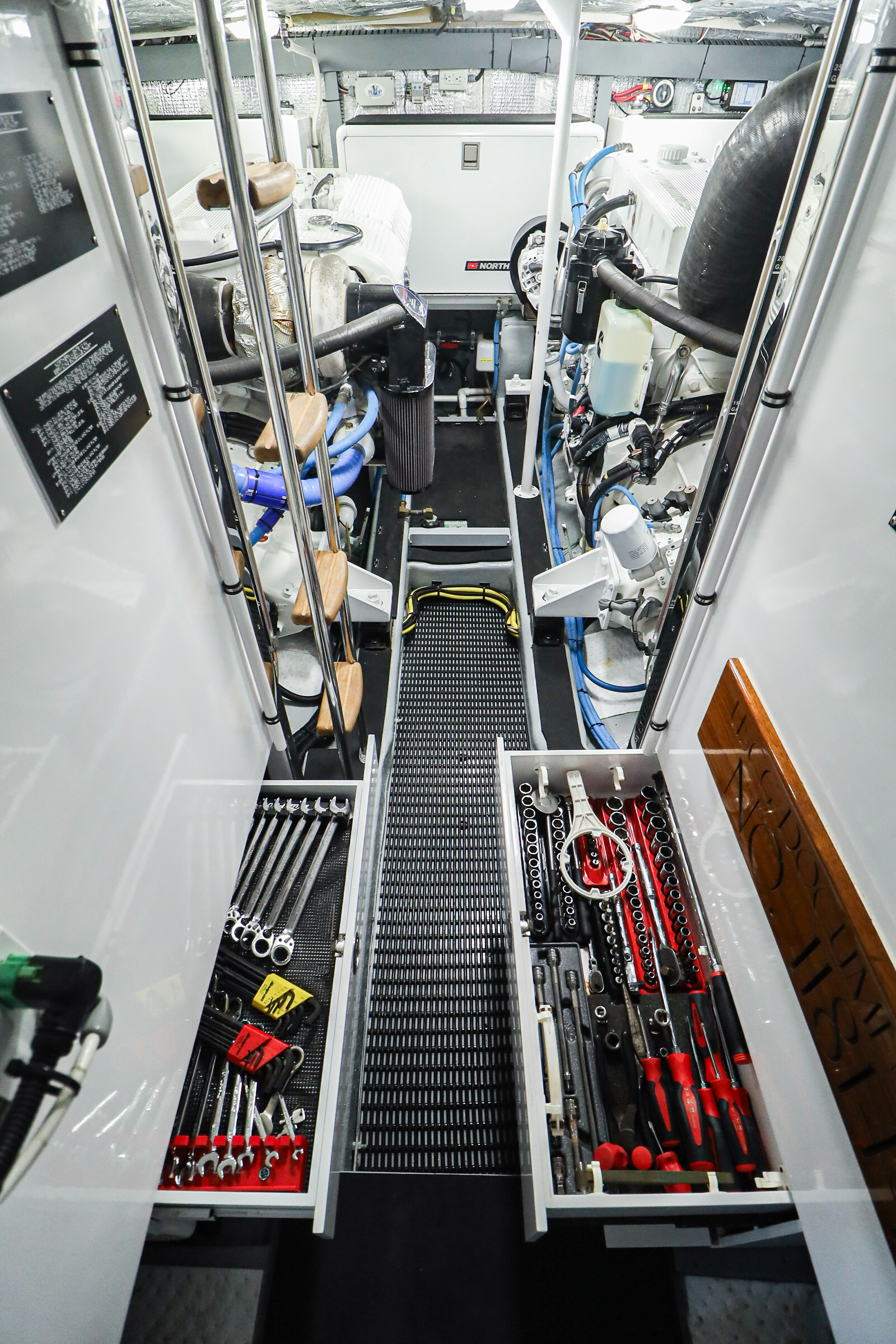
-
by admin
I. Introduction
In the world of luxury yachting, proper yacht maintenance is not just a task—it’s an art form that preserves both beauty and functionality. For discerning yacht owners, understanding the intricacies of yacht care is crucial for protecting their investment, ensuring optimal performance, and guaranteeing the safety of everyone on board. Regular upkeep is the cornerstone of responsible yacht ownership, significantly extending the life of your vessel, maintaining its value, and providing you with worry-free enjoyment on the water.
A. Importance of yacht maintenance
- Preserving Investment Value: A well-maintained yacht retains its value over time. Regular care prevents deterioration and keeps your vessel in top condition, which is crucial when selling or trading up.
- Ensuring Reliability and Longevity: Consistent maintenance schedules prevent unexpected breakdowns and extend the life of your yacht’s systems. This reliability is essential for both safety and enjoyment during your maritime adventures.
- Preventing Costly Repairs: Properly addressing minor issues through regular maintenance can prevent them from escalating into major, expensive problems. This proactive approach saves time and money in the long run.
B. Impact on performance, value, and safety
- Enhanced Performance: Well-maintained yachts perform better on the water. Proper care optimizes every aspect of your yacht’s performance, from fuel efficiency to speed and handling.
- Value Retention: Regular maintenance helps retain and even increase your yacht’s resale value. Prospective buyers often pay a premium for a meticulously maintained vessel.
- Safety Assurance: Perhaps most importantly, proper upkeep is crucial for onboard safety. Well-maintained engines, electrical systems, and safety equipment provide peace of mind and protection for you and your guests.
II. Hull and Exterior Maintenance
The hull and exterior of your yacht are its first line of defense against the harsh marine environment. Regular care of these surfaces is essential not only for aesthetics but also for your vessel’s overall integrity and performance.
A. Regular cleaning and waxing
- Frequent Washing: Regularly remove salt, grime, and marine growth using specialized marine cleaners. This prevents corrosion and maintains the yacht’s appearance.
- Proper Techniques: Use soft cloths or sponges to avoid scratching the surface. Work from top to bottom to prevent streaking.
- Quality Marine Wax: To protect the finish, apply high-quality marine wax. This creates a barrier against UV rays, salt, and other environmental factors.
- Waxing Schedule: For optimal protection, plan to wax your yacht every 3-4 months, depending on its usage and climate.
B. Bottom painting and antifouling
- Antifouling Paint Application: Antifouling paint prevents marine growth on the hull below the waterline, improving fuel efficiency and performance.
- Types of Antifouling Paint: Depending on your yacht’s usage and local environmental regulations, choose between hard, ablative, or semi-ablative paints.
- Regular Haul-outs: Schedule haul-outs every 12-18 months for bottom inspection and repainting. This allows for a thorough check of the hull’s condition.
- Professional Application: Consider professional application for the best results and longevity of the antifouling coating.
C. Gelcoat care and repair
- Prompt Repair: Promptly address scratches and chips in the gel coat to prevent water intrusion and further damage.
- Matching Colors: Use color-matched gel coat for repairs to maintain a seamless appearance.
- Annual Polishing: Polish the gel coat annually to maintain its luster and protect it from oxidation.
- Sealing: Apply a high-quality marine sealant after polishing to provide extra protection against the elements.
D. Teak deck maintenance
- Gentle Cleaning: Clean teak decks with appropriate, pH-neutral cleaners to avoid damaging the wood fibers.
- Proper Tools: Use soft bristle brushes and work with the grain to preserve the teak’s natural texture.
- Regular Oiling: Regularly oil or seal the teak to prevent drying and cracking. This maintains the wood’s appearance and integrity.
- Professional Restoration: Consider professional restoration services every few years to sand and refinish heavily worn teak decks.
By focusing on hull and exterior maintenance aspects, you’ll ensure that your yacht not only looks its best but also performs optimally and maintains its value over time. Remember, the exterior of your yacht reflects your commitment to quality and attention to detail in the world of luxury yachting.
III. Engine and Mechanical Systems
The heart of your luxury yacht lies in its engine and mechanical systems. Proper care ensures reliable performance, prevents unexpected breakdowns, and maintains the vessel’s value. Let’s dive into the essential aspects of engine and mechanical system maintenance.
A. Routine engine maintenance
- Oil and Filter Changes: Adhere to manufacturer recommendations for oil and filter changes. This typically ranges from every 100 hours of operation or annually, whichever comes first.
- Belt and Hose Inspection: Regularly check and replace belts and hoses as needed. Look for signs of wear, cracking, or glazing on belts, and check hoses for softness, bulges, or leaks.
- Fluid Level Monitoring: Maintain proper engine oil, coolant, and transmission fluid levels. Use high-quality marine-grade fluids suitable for your specific engine type.
- Fuel System Care: Regularly inspect fuel lines for leaks or wear. Clean or replace fuel filters according to the manufacturer’s schedule.
- Impeller Inspection: Check the raw water pump impeller annually or every 300 hours. Replace it if it shows signs of wear or damage.
B. Propeller and shaft care
- Regular Inspections: Inspect propellers for damage, such as nicks, dents, or bent blades. Even minor damage can affect performance and fuel efficiency.
- Propeller Balancing: Have propellers professionally balanced to reduce vibration and improve efficiency.
- Shaft Alignment: Check shaft alignment annually or after any significant engine work. Misalignment can cause excessive wear and vibration.
- Cutlass Bearing Checks: Inspect cutlass bearings for wear. Excessive play in the propeller shaft indicates it’s time for replacement.
- Zinc Anode Replacement: Regularly check and replace sacrificial zinc anodes to prevent galvanic corrosion.
C. Generator upkeep
- Regular Testing: Run the generator regularly under load, even when not in use, to prevent fuel system issues and ensure reliability.
- Maintenance Schedule: Follow the manufacturer’s maintenance schedule, which typically includes oil and filter changes, impeller inspections, and belt checks.
- Exhaust System Inspection: Regularly check the generator’s exhaust system for leaks or damage to prevent dangerous carbon monoxide infiltration.
- Cooling System Care: Flush and clean the generator’s cooling system annually to prevent overheating and ensure efficient operation.
D. Hydraulic system maintenance
- Fluid Level Checks: Regularly check hydraulic fluid levels and top up with the correct fluid grade as needed.
- Fluid Analysis: Conduct annual hydraulic fluid analysis to detect contaminants or wear particles that could indicate system issues.
- Hose and Fitting Inspection: Inspect hydraulic hoses and fittings regularly for leaks, wear, or damage. Replace components showing signs of deterioration.
- System Pressure Checks: Periodically check system pressures to ensure optimal performance of hydraulic components like steering, stabilizers, and thrusters.
IV. Electrical Systems
Modern luxury yachts rely heavily on sophisticated electrical systems for navigation, comfort, and safety. Proper maintenance of these systems is crucial for a safe and enjoyable boating experience.
A. Battery care and replacement
- Regular Inspections: Check batteries monthly for signs of corrosion, leakage, or damage.
- Water Levels: For lead-acid batteries, only check and maintain proper water levels using distilled water.
- Charge Monitoring: Use a smart charger to maintain optimal charge levels, especially during periods of inactivity.
- Replacement Schedule: Replace batteries every 3-5 years or as the manufacturer recommends, even if they seem to function well.
- Proper Storage: When storing batteries for extended periods, use a trickle charger to maintain charge and prevent sulfation.
B. Solar panel maintenance (if applicable)
- Regular Cleaning: To maintain optimal efficiency, solar panels must be kept clean from salt spray, bird droppings, and other debris.
- Connection Checks: Regularly inspect wiring connections for corrosion or looseness. Tighten connections and apply dielectric grease as needed.
- Performance Monitoring: A solar charge controller with monitoring capabilities can track system performance and identify issues early.
- Professional Inspections: Schedule annual professional inspections to ensure all components function correctly and efficiently.
C. Navigation and communication equipment upkeep
- Software Updates: Regularly update charts, radar software, and other navigation systems to ensure accuracy and access to the latest features.
- Antenna Care: Inspect and clean antennas regularly. Check for physical damage or corrosion that could affect performance.
- Display Maintenance: Clean display screens with appropriate products and check for pixel issues or other display abnormalities.
- Backup Systems: Regularly test and maintain backup navigation and communication systems to ensure they’re ready when needed.
D. Lighting system care
- LED Upgrades: Consider upgrading to LED lighting for improved efficiency and longevity.
- Regular Testing: Regularly test all lighting systems, including navigation lights, to ensure proper function.
- Fixture Inspection: Check light fixtures for water intrusion or corrosion, especially in exterior locations.
- Wiring Checks: Inspect wiring connections for signs of wear, heat damage, or corrosion. Address any issues promptly to prevent electrical fires.
V. Interior Care
The interior of your yacht is your home away from home on the water. Regular maintenance ensures a comfortable, hygienic, and luxurious environment for you and your guests.
A. Upholstery and carpet cleaning
- Regular Vacuuming: Vacuum carpets and upholstery weekly to prevent dirt and salt from becoming embedded in fibers.
- Stain Treatment: Address spills and stains immediately using appropriate marine-grade cleaning products.
- Professional Cleaning: Schedule professional deep cleaning of carpets and upholstery annually or bi-annually, depending on usage.
- Fabric Protection: Apply marine-grade fabric protectors to upholstery to resist stains and make cleaning easier.
B. Wood and surface care
- Dust Prevention: Use air purifiers and dehumidifiers to reduce dust and prevent moisture damage to wood surfaces.
- Proper Cleaning: Clean wood surfaces with products specifically designed for marine use. Avoid harsh chemicals that can damage finishes.
- Oiling and Varnishing: Maintain interior wood with regular oiling or varnishing as appropriate for the specific wood type and finish.
- Scratch Repair: Promptly address minor scratches in wood surfaces using color-matched fillers or touch-up kits.
C. Climate control system maintenance
- Filter Replacement: Clean or replace air filters in air conditioning and heating systems monthly during the boating season.
- Duct Inspection: Annually inspect and clean air ducts to prevent mold growth and ensure efficient airflow.
- Refrigerant Checks: Check refrigerant levels in air conditioning systems annually and recharge as needed.
- Dehumidifier Use: Use dehumidifiers in less-ventilated areas to prevent mold and mildew growth.
D. Plumbing and head system upkeep
- Regular Flushing: Flush all freshwater systems regularly, especially after periods of inactivity.
- Tank Cleaning: To prevent odors and bacterial growth, clean and sanitize freshwater and waste tanks annually.
- Leak Checks: Regularly inspect all plumbing connections and fixtures for leaks or signs of corrosion.
- Pump Maintenance: Service freshwater pumps and waste macerators according to manufacturer recommendations.
By maintaining these crucial systems, you ensure that your luxury yacht remains in top condition and provides comfort, safety, and reliability for all your maritime adventures.
VI. Safety Equipment Maintenance
In the world of luxury yachting, safety should always be the top priority. Regular checks and maintenance of safety equipment are not just regulatory requirements but can be lifesavers in emergency situations.
A. Life raft inspections
- Professional Servicing: Schedule professional life raft inspections at intervals recommended by the manufacturer, typically every 1-3 years.
- Visual Checks: Conduct monthly visual inspections of the life raft container for signs of damage or water ingress.
- Hydrostatic Release: Check the expiration date on hydrostatic release units and replace as needed, usually every two years.
- Proper Storage: Ensure life rafts are stored in easily accessible locations and secured properly to prevent damage during rough seas.
B. Fire suppression system checks
- Extinguisher Inspections: Check fire extinguishers monthly for proper pressure and signs of damage. Replace or recharge as needed.
- Fixed System Testing: Test fixed fire suppression systems annually, including engine room systems and galley suppression units.
- Smoke Detectors: Test all smoke and carbon monoxide detectors monthly and replace batteries annually.
- Fire Blankets: Inspect fire blankets for damage and ensure they are easily accessible in galley areas.
C. Emergency communication device testing
- EPIRB Maintenance: Check Emergency Position Indicating Radio Beacons (EPIRBs) monthly for battery life and proper registration.
- VHF Radio Testing: If equipped, Test VHF radios regularly, including DSC functionality.
- Satellite Phone Checks: If equipped with a satellite phone, test it monthly and keep it fully charged.
- Personal Locator Beacons: Inspect and test personal locator beacons (PLBs) according to manufacturer guidelines.
D. First aid kit updates
- Regular Inventories: Conduct quarterly first aid supply inventories and replace expired items.
- Customization: You can customize the contents of your first aid kit based on your cruising area and the specific medical needs of frequent passengers.
- Prescription Medications: If carrying prescription medications, check expiration dates regularly and replace them as needed.
- Training: Ensure key crew members are trained in first aid and CPR, with refresher courses taken annually.
VII. Seasonal Maintenance
Different seasons bring unique challenges for yacht maintenance. Proper seasonal care protects your investment year-round and ensures your vessel is ready for action when you are.
A. Winterization procedures
- Engine Winterization: Flush engines with antifreeze and fog cylinders to prevent corrosion during storage.
- Water System Draining: Drain all water systems, including freshwater tanks, water heaters, and air conditioning units.
- Battery Care: Remove batteries and store them in a warm, dry place connected to a trickle charger.
- Interior Preparation: Remove all perishables, clean thoroughly, and use moisture absorbers to prevent mold growth.
- Exterior Protection: Apply a high-quality boat cover or shrink wrap to protect against snow, ice, and UV damage.
B. Spring commissioning
- Hull Inspection: Conduct a thorough hull inspection to look for any damage that may have occurred during winter storage.
- Systems Check: Test all onboard systems, including engines, generators, and electronics, before launching.
- Bottom Preparation: Clean the hull bottom and apply fresh antifouling paint if needed.
- Safety Equipment: Inspect all safety equipment and replace any expired items.
- Fluids and Filters: Change all fluids and filters in engines, generators, and other mechanical systems.
C. Storm preparation
- Secure Vessel: Develop and practice a storm preparedness plan for securing your yacht, whether in a marina or at anchor.
- Remove Loose Items: Secure or remove all loose deck items, including cushions, light fixtures, and antennas.
- Extra Lines: Prepare extra mooring lines and fenders for use in storm conditions.
- Bilge Pump Check: Ensure bilge pumps function properly and have backup power sources.
- Insurance Review: Review your yacht insurance policy to understand coverage for storm-related damage.
VIII. Professional Services vs. DIY
While many yacht owners enjoy hands-on maintenance, some tasks require professional expertise. Striking the right balance ensures optimal care for your vessel.
A. When to call in the experts
- Engine Overhauls: Major engine work, including overhauls and alignments, should be performed by certified marine mechanics.
- Electrical System Upgrades: Complex electrical work, especially involving high-voltage systems, requires professional marine electricians.
- Structural Repairs: Professionals should perform any repairs to the yacht’s structure, including fiberglass work or welding.
- Navigation System Installation: Installation and calibration of complex navigation systems are best left to certified technicians.
B. Tasks suitable for owner maintenance
- Regular Cleaning: With proper knowledge and tools, owners can perform exterior washing, interior cleaning, and basic detailing.
- Fluid Checks: Routine checks and top-ups of engine oil, coolant, and other fluids are suitable for DIY maintenance.
- Basic Woodwork: With proper preparation, owners can easily varnish and oil teak and other wood surfaces.
- Minor Repairs: Small cosmetic repairs, such as gel coat touch-ups or simple upholstery repairs, can be owner-performed with care.
C. Importance of documentation
- Maintenance Logs: Keep detailed records of all maintenance performed, including dates, procedures, and parts used.
- Receipt Retention: Save all receipts and documentation for maintenance work and part replacements for warranty purposes.
- Digital Records: Use yacht management software to track maintenance schedules and keep digital records.
- Resale Value: Comprehensive maintenance records can significantly enhance your yacht’s resale value.
IX. Technology in Yacht Maintenance
Advancements in technology are revolutionizing yacht maintenance, making it more efficient and effective.
A. Monitoring systems
- Engine Monitoring: Install systems that track engine hours, fuel consumption, and performance metrics.
- Bilge Monitoring: Use smart bilge pump monitors with remote alerts for early leak detection.
- Environmental Monitoring: Employ systems that track temperature, humidity, and air quality to prevent mold and mildew issues.
B. Predictive maintenance software
- Maintenance Scheduling: Utilize apps or software to schedule and track maintenance tasks based on usage and manufacturer recommendations.
- Predictive Analytics: Implement systems that use data analysis to predict potential failures before they occur.
- Parts Inventory: Use software to manage spare parts inventory and automate reordering of critical components.
C. Remote diagnostics
- Telematics: Install telematics systems for real-time engine and system performance data that is accessible from anywhere.
- Remote Troubleshooting: Use systems that allow technicians to perform remote diagnostics and troubleshooting.
- Satellite Connectivity: Invest in satellite communication systems for maintenance support in remote locations.
X. Environmental Considerations
Yacht owners are responsible for maintaining their vessels in an eco-friendly manner as stewards of the marine environment.
A. Eco-friendly cleaning products
- Biodegradable Cleaners: Choose cleaning products that are biodegradable and phosphate-free to minimize environmental impact.
- Natural Alternatives: Use natural cleaning alternatives like vinegar and baking soda where appropriate.
- Microfiber Tools: Employ microfiber cloths and mops to reduce the need for chemical cleaners.
B. Proper waste disposal
- Oil Recycling: Properly dispose of used oil and filters at certified recycling facilities.
- Battery Disposal: Recycle old batteries through appropriate channels to prevent environmental contamination.
- Sewage Management: Use pump-out stations for proper sewage disposal and maintain onboard treatment systems.
C. Sustainable maintenance practices
- Water Conservation: Implement water-saving measures during cleaning and maintenance activities.
- Energy Efficiency: Use energy-efficient appliances and LED lighting to reduce power consumption.
- Sustainable Materials: Choose sustainable materials for repairs and upgrades when possible.
XI. Conclusion
A. Long-term benefits of proper maintenance
- Enhanced Resale Value: A well-maintained yacht commands a higher resale price and attracts discerning buyers.
- Lower Ownership Costs: Regular maintenance prevents costly repairs and extends the life of your yacht’s systems.
- Improved Safety: Proper upkeep ensures the safety of you, your guests, and your crew during your maritime adventures.
B. Balancing enjoyment and upkeep
- Maintenance Schedule: Create a balanced maintenance schedule that doesn’t interfere with your boating pleasure.
- Yacht Management Services: Consider yacht management services to handle routine maintenance, allowing you to focus on enjoyment.
- Owner Involvement: Stay involved in the maintenance process to understand your yacht’s needs and appreciate its care.
By following these comprehensive maintenance guidelines, you’ll ensure that your luxury yacht remains a source of pride and joy for years to come. Remember, a well-maintained yacht preserves your investment and provides peace of mind for worry-free adventures on the open seas.
Keywords: yacht maintenance, boat care, marine services, hull cleaning, gel coat repair, teak deck maintenance, antifouling paint, yacht waxing, exterior yacht care, engine maintenance, marine electrical systems, interior yacht care, boat plumbing, climate control systems, upholstery cleaning, wood care, generator maintenance, hydraulic system upkeep, battery maintenance, solar panel care, navigation equipment, yacht safety equipment, seasonal yacht maintenance, DIY boat care, professional yacht services, marine technology, eco-friendly boating, yacht documentation, predictive maintenance, remote diagnostics, sustainable yachting practices


